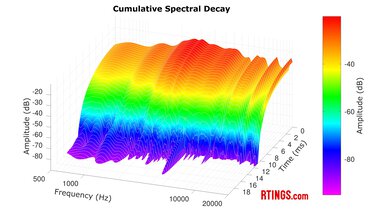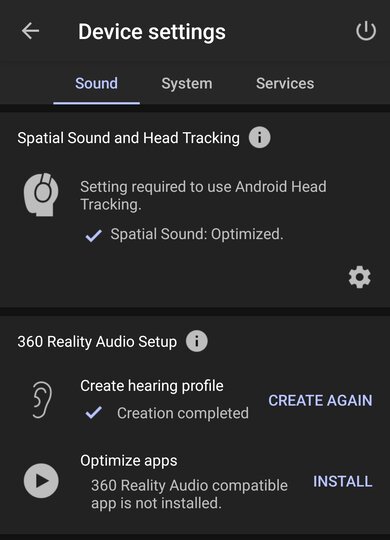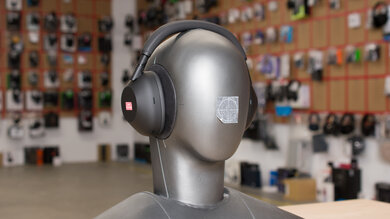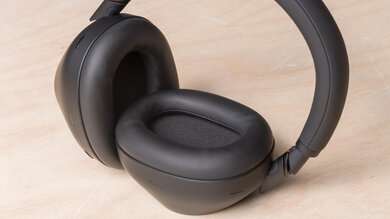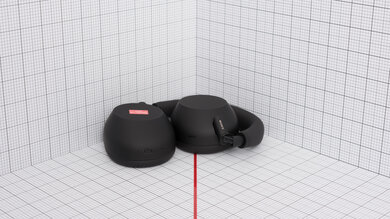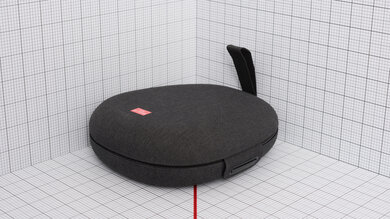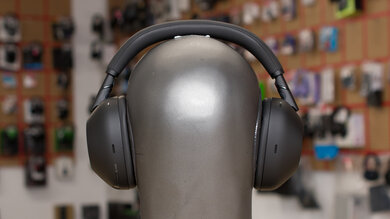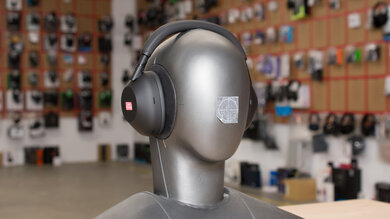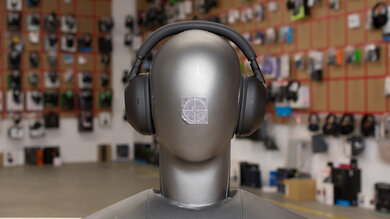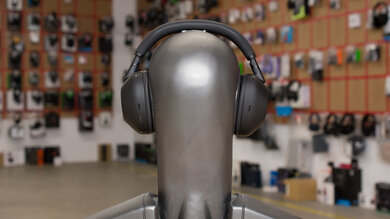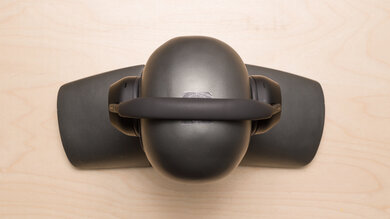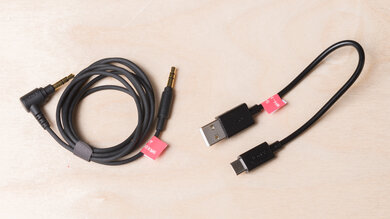Released to wide fanfare in May 2025, the Sony WH-1000XM6 are the direct successor to the manufacturer's 2022 flagship, the Sony WH-1000XM5 Wireless. While they don't mark a major shift in design, a handful of subtle tweaks to the appearance and internals aim to push them further ahead of previous generations and much of the current competition. Among the most notable changes are support for Bluetooth LE's LC3 codec and a redesigned folding hinge. Sony also claims improved ANC performance, backed by the addition of extra microphones and a faster QN3 processor. Together, these upgrades position the XM6 as a refinement rather than a reinvention of their flagship entry.
Our Verdict
The Sony WH-1000XM6 are decent for sports and fitness, though they aren't designed for this use case. While they have a comfortable fit and a solid build, they aren't particularly stable; don't expect the headphones to stay put while you run in the park. That said, if you plan on using them on a stationary bike, they'll probably stay on your head, allowing you to benefit from their incredible noise suppression, cutting noise from deadlifters dropping weights to the floor.
Considerable battery life.
Comfortable, lightweight design with low clamping force.
Unstable with intense movement.
Audio delivery consistency issues.
The Sony WH-1000XM6 are amazing for travel. They have a fantastic continuous 31.75-hour battery life with ANC enabled, so you'll be covered for even the longest international flights. Plus, their handy case has a magnetic closing mechanism for speedy headphone storage if you need to stow them quickly. Their powerful ANC system also easily reduces environmental noise from airplane engines or chattering commuters. Meanwhile, their light weight and clamping force make it a piece of cake to wear the XM6 for extended periods of time. You can also configure the app to automatically enable noise cancelling when you ride a vehicle like a bus or train on your daily commute.
Incredible noise attenuation.
Considerable battery life.
Low hassle magnetic clasp case.
Audio delivery consistency issues.
The Sony WH-1000XM6 are excellent for office work. If you work in a crowded office or at home with kids, the headphones' incredible ANC system easily attenuates noise from your environment, allowing you to lock in for a productivity sprint. Their battery lasts over 31 hours, so if you forget to charge them every day, you likely won't run into any issues. The XM6 also have expanded additional controls, including head gestures to accept or decline calls and a dedicated shortcut to mute/unmute your mic. Their amazing microphone system renders your voice clearly and with depth and warmth, so you'll remain intelligible on Microsoft Teams calls.
Incredible noise attenuation.
Considerable battery life.
Impressive microphone performance.
Audio delivery consistency issues.
The Sony WH-1000XM6 aren't widely usable for wireless gaming. While you can connect them via Bluetooth LE, the feature is still in beta, and a limited number of devices can communicate with the headphones using this connection. That said, if you have a compatible phone or Bluetooth LE dongle, you'll likely have low enough latency that audio-visual desync isn't an issue even when playing games.
The Sony WH-1000XM6 are very good for wired gaming. While their microphone won't function while connected to devices using an AUX cable, you can still enjoy clear, detailed audio for offline modes or story gameplay. The headphones have a lightweight, comfortable fit that makes long sessions a breeze as long as you have the stamina. And since you can use the top-tier ANC while the headphones are plugged in, you can eliminate environmental distractions and in-game adversaries simultaneously.
Comfortable, lightweight design with low clamping force.
Near-zero latency on analog connection even while powered on.
Audio delivery consistency issues.
The Sony WH-1000XM6 have good audio reproduction accuracy. Across most of the audible spectrum, their frequency response deviates minimally from their warm tuning, with narrow dips that subtly affect the upper harmonics of vocals and instruments in the mid- and high-treble. The headphones' L/R drivers have minor stereo matching issues, which can bias low-register instruments and vocals to the right while reducing the clarity of audio objects of higher pitch. Group delay is well-controlled, producing tight kicks, and harmonic distortion stays low, even at higher levels, so output remains free of coloration. Additionally, the headphones' PRTF measurements somewhat resemble our reference curve, indicating outer ear stimulation that contributes to a more immersive listening experience. That said, your experience can differ from our measurements, depending on your physical characteristics; check out Frequency Response Consistency for more information.
The Sony WH-1000XM6 are outstanding for noise isolation. The collective noise suppression of the earpads and ANC system easily cuts noise across most of the frequency spectrum from the screech of upstairs neighbors rearranging furniture to the hum of an air conditioner compressor. That said, performance may vary depending on the headphones' fit and physical factors like whether you wear glasses.
The Sony WH-1000XM6 have a very good microphone system. Your voice on calls will sound full-bodied and intelligible. The headphones easily separate background noise from your voice, protecting your conversation partner(s) from loud or unexpected noise. That said, in extremely harsh conditions, your voice may lose intelligibility as a trade-off. The XM6 also support Bluetooth LE and LC3, which facilitate improved microphone quality in two-directional signaling. Though it's not compatible with many devices, this alternative connection is a noticeable improvement over the standard protocol.
The Sony WH-1000XM6 have passable frequency response consistency. Depending on your physical characteristics, our frequency response measurements may not be representative of your listening experience. Even after taking the time to seat the headphones, you may experience variability in audio delivery across the audible spectrum, particularly if you wear glasses.
Performance Usages
Changelog
-
Updated Jul 24, 2025:
Based on community feedback, we've retested these headphones' frequency response and noise isolation with firmware update 2.0.2. While we observed no changes in the results, we've updated the text in the Sound Profile and Noise Isolation - Full Range boxes.
- Updated Jun 18, 2025: Review published.
- Updated Jun 11, 2025: Early access published.
- Updated Jun 02, 2025: Our testers have started testing this product.
Check Price
Differences Between Sizes And Variants
The Sony WH-1000XM6 come in three colors: 'Black,' 'Midnight Blue,' and 'Platinum Silver.' Our unit is 'Black' and you can see a photo of its label here.
If you encounter a variant or additional colorways, please let us know in the comments, and we'll update the review.
Popular Headphones Comparisons
The Sony WH-1000XM6 join the lineup of Sony's recent flagships, sitting alongside the Sony WH-1000XM5 Wireless and Sony WH-1000XM4 Wireless. While all three have their respective strengths, the XM6 edge out their predecessors across most performance metrics—but they also come at the highest price point. The XM5 have a similar sound profile and slightly less effective ANC, but are held back by reports of durability issues and a design that some users find uncomfortable. Meanwhile, the XM4 remain a compelling budget-friendly option, though they fall short of the XM5 and XM6's mic performance.
Looking beyond Sony, the Bose QuietComfort Ultra Headphones Wireless live up to their name with deeper ear cups and better comfort overall, particularly for users with more varied ear shapes, while the Focal Bathys, with their audiophile focus, deliver audio more consistently across different individuals and listening sessions. That said, neither matches the Sony XM6 in overall noise suppression, though the difference isn't enormous. Meanwhile, the Apple AirPods Max offer seamless support for spatial audio and head tracking on iOS—features missing from the Sony when connected with Apple devices.
If you're jumping between budgets or considering Bluetooth earbuds, check out our articles for the best headphones, best budget wireless headphones, and best wireless earbuds.
While the Bose QuietComfort Ultra Headphones Wireless and Sony WH-1000XM6 are both premium headphones and are priced accordingly, the Sony are a step above in most performance metrics. They have a better microphone system and audio reproduction accuracy overall. However, while both headphones have a warm tuning, the Sony's bass emphasis bleeds more into the mids, which can cause dense mixes to sound muddled relative to the Bose. In terms of features, the Sony's more recent release date and positioning affords them the benefit of expanded functionality, including extensive virtual soundstage features, and the LC3 and LDAC codecs. That said, the Bose still support an analogous Hi-Res codec with aptX Adaptive, which also brings wider compatibility for low latency than LC3. The Bose are also more comfortable and have deeper ear cups, which can make a big difference depending on your physical characteristics.
The Sony WH-1000XM6 outperform the Sennheiser MOMENTUM 4 Wireless in most areas. Their noise suppression is more effective across the frequency spectrum and against sounds like airplane engines or background chatter. The Sony also pulls ahead with a more capable microphone system and support for extra features, including virtual surround sound, Bluetooth LE, and gesture-based controls. That said, the Sennheiser hold their own with some practical advantages: adjustable noise cancelling and nearly double the battery life.
While the Sony WH-1000XM6 are certified Made for iPhone (MFi), the Apple AirPods Max are still the better option for use in the Apple ecosystem. Although the Sony have better performance in most metrics like noise attenuation, microphone quality, and customizability of both function and sound, the AirPods Max have more replicable audio delivery across individuals and between reseats, making their sound reproduction more predictable and consistent. That said, if you're not in the Apple ecosystem, the AirPods Max probably aren't the pick for you, as you'll lose a lot of functionality. If you're on iOS or running macOS, it's a toss-up between the two products, depending on what you prioritize, though it's worth mentioning that you won't have access to head tracking on the Sony outside of Android.
The Sony WH-1000XM6 are the successor to the Sony WH-1000XM5 Wireless. While they address many of the concerns raised about the previous model—making them a stronger all-around choice—the XM5 still hold their own, especially if you're aiming to get the most for your money. The XM6 introduce a redesigned hinge and flatter headband that offer a more comfortable fit and a sturdier build. However, they make tradeoffs elsewhere; their softer pads are more prone to seal interruptions from physical factors like glasses or slight shifts in positioning. This can lead to inconsistent sound delivery, which may be a dealbreaker if you wear glasses. On the upside, the XM6 show marked improvements in noise attenuation—especially in the mid-range—making them more effective at cutting out office chatter and the clack of keyboards. Ultimately, the decision between the XM5 and XM6 comes down to whether you prioritize the XM6's performance gains and extra features, or prefer the more consistent fit and lower price of the XM5.
Test Results

The Sony WH-1000XM6 have a warm sound profile that resembles our in-house target curve with a bit more bass emphasis. While prominent dips in their signature may initially stand out, the headphones' sound mostly resembles that of the Sony WH-1000XM5, and listeners will likely adapt to their sound over time. That said, you can easily customize their sound with the included EQ presets and an expanded 10-band graphic EQ. The app also includes a 'Find My EQ' feature that takes you through a questionnaire with audio clips before generating a custom preset.
Like many other ANC headphones, the XM6 have a different frequency response with ANC on/off. While you can also use the headphones wired and completely passively, their sound signature is de-emphasized in the bass and treble. That said, you'll likely still notice some differences in the mids when wired, even with the headphones powered on.
After observing user requests to measure the frequency response after firmware update 2.0.2, we re-tested these headphones with their firmware updated. However, we didn't notice any changes in the frequency response that couldn't be attributed to variations caused by reseating the headphones.
The Sony WH-1000XM6 have mediocre frequency response consistency that presents noticeable challenges compared to their predecessors, like the Sony WH-1000XM5 and Sony WH-1000XM4. A primary factor causing inconsistency in audio delivery is the design of the earpads. Their susceptibility to deformation can compromise the headphones' seal, depending on your physical characteristics, and is especially noticeable for users wearing glasses in the delivery of bass frequencies. Variability in audio delivery also extends to the mids and treble, where physical differences and reseats can affect how vocals and lead instruments are perceived.
While these issues might not heavily impact casual listeners, they're relevant enough to consider if consistent detail is important to you. If you're looking for Bluetooth headphones more suited to critical listening, check out the Focal Bathys.
They have very good bass target compliance. Their bass response is elevated across the range with a slight taper down toward the mids. In songs like Redbone by Childish Gambino, the suspenseful kicks before the instrumental opening sound warm and full-bodied.
They have excellent mid-range target compliance. Elevation from the bass bleeds slightly into the low-mids, which may muddle complex mixes. The rest of the range closely matches our target, so most vocals and instruments will sound clear and present.
They have excellent treble compliance, closely matching our target curve through the majority of the treble range. That said, two prominent notches in the mid- and high-treble can affect the presence and airiness of percussion and higher-pitched vocals and instruments. In tracks like Voyager by Daft Punk, with a variety of percussion, different types of cymbals can sound hushed or sparkly depending on the pitch.
The Sony WH-1000XM6's peaks and dips performance is decent. The headphones' frequency response adheres to their warm sound profile, though larger fluctuations can be noticeable. Prominent, but narrow dips in the mid- and high-treble can affect the upper harmonics of instruments. As a result, percussive elements like high-pitched pizzicato and cymbals may sound dull or jump out in the mix as neighboring frequencies are under- or over-emphasized relative to one another.
These headphones' L/R drivers are decently well-matched. They have a minor frequency and amplitude bias toward the right channel from the bass to the mid-mids; this can shift lower-pitched instruments and vocals slightly off-center. Meanwhile, more prominent fluctuations in phase and frequency in the mid-range and above can reduce precision in the positioning of audio objects in the stereo image. That said, this is most impactful in the mids as we're less sensitive to phase issues at higher frequencies.
The Sony WH1000XM6 have amazing group delay performance. The headphones reproduce tight bass and transparent treble.
The Sony XM6 have passable pinna interaction with a PRTF that resembles our reference curve. That said, the headphones can't accurately replicate the experience of listening to an angled stereo speaker setup.
These headphones have exceptional harmonic distortion performance. Even at high levels, the harmonics generated by the headphones will not cause perceivable coloration in your audio.
These headphones don't require an amp to drive them, and can easily be powered by your desktop or laptop when connected via headphone jack. That said, they sound quite different when powered on/off.
Most of the headphones' virtual surround features are available through Sony Sound Connect. 360 Reality Audio creates a unique hearing profile by analyzing your ear shape using a listening test, though you'll need to use a supported service like Amazon Music Unlimited to use the feature.
If you have a supported Android device, you can also enable Spatial Audio and Head Tracking in your device settings after completing 'Spatial Sound Optimization' in the headphones' app. This allows for a more immersive listening experience with Dolby Atmos content on supported apps. It's worth pointing out that Samsung Android devices don't have access to Google's Spatial Audio and Head Tracking implementation, so these features won't be available.
The headphones also have 'Listening Modes,' which apply a virtual soundstage to all content. You can pick from Background Music and Cinema. Background Music simulates the soundstage of rooms with increasing size: My Room, Living Room, and Cafe. Meanwhile, Cinema acts as a speaker modeling feature and can upmix stereo content, though this can cause deliberately positioned audio objects in stereo tracks like Bohemian Rhapsody by Queen to shift to the center. With either feature enabled, you'll lose access to EQ customizations.
These are the settings used to test these headphones. Our results are only valid when used in this configuration.
The Sony XM6 have a very similar design to the Sony WH-1000XM5. They represent a subtle evolution rather than a dramatic redesign of Sony's flagship style. Most notably, the headband is more square-shaped, while the hinges feature a more robust swivel and folding mechanism without significantly altering the overall aesthetic when worn. The flat control surfaces have a more circular shape compared to the previous stadium shape. Additionally, the microphone grilles have been color-matched to the rest of the body, enhancing the visual coherence of the headphones. The headphones retain the high-end satin finish from their predecessor and come in three color variants: 'Black,' 'Platinum Silver,' and 'Midnight Blue.'
The Sony XM6 have a comfortable fit that's light and flexible. Their weight and clamping force are functionally identical to the Sony WH-1000XM5 Wireless. That said, the headband has a flatter cross-section, effectively distributing weight across the top of the head, which noticeably reduces fatigue during extended listening sessions. The ear cups feature softer, squishier foam for improved initial comfort compared to the XM5, though their shallowness might cause agitation from your ears touching the drivers or mounted microphone through the mesh. Despite being comfortable to wear for long stretches, even with glasses, the ear cups are also susceptible to potential consistency issues. If you're looking for comfier headphones with deeper ear cups, consider the Bose QuietComfort Ultra Headphones Wireless.
These headphones have great controls that are intuitive and responsive, mixing both touch and button controls. The headphones' redesigned circular power button makes it easier to differentiate from the adjacent ambient/noise cancelling button—an improvement over the nearly identical buttons on their predecessor. You can also enable a unique bind to mute/unmute the microphone when on calls, and setup voice commands to adjust headphone functions. The headphones have unique chimes for playback controls, increasing/decreasing volume, and when hitting min/max volume, which provide useful audio feedback. That said, the touch surface can sometimes fail to register your inputs or register the wrong input.
On the left ear cup:
Power button:
- Press and hold: Turns headphones on or off. If you continue to hold this button past turning the headphones on (5 seconds), you'll enter Bluetooth pairing mode.
NC/AMB button:
- One press: Cycles between ANC on and talk-through mode (can be customized in-app to include ANC off).
- Double press on call (requires toggle in app): Mute/unmute microphone.
There are touch controls on the right ear cup, and you can also enable nod controls for accepting/declining calls.
The Sony WH-1000XM6 aren't very portable, which is normal for over-ear headphones. They have mixed material hinges attached to each ear cup that allow you to fold the headphones to reduce their footprint, shaving off a centimeter here and there compared to the Sony WH-1000XM5.
The Sony WH1000XM6 have a great case with an innovative magnetic clasp instead of a traditional zipper. The case has an outer shell with a soft inner lining, which should protect the headphones from some falls and in your bag. You can also store additional cables and small accessories in a dedicated cutout inside the case.
The Sony WH-1000XM6 have a great build quality, offering a slight improvement over their predecessor. Their hinge incorporates a combination of metal and plastic, providing a sturdy folding and twisting mechanism. However, the rest of the headphone body remains predominantly plastic, including the area around the hinge, which could potentially be a weak point under heavy or prolonged use. Their earpads are also conveniently detachable, so you can easily replace them if they wear out.
The included cable feels slightly thin, although the 90-degree connector is practical for phone connections. Additionally, the headphones don't have an IP rating; though this is typical for over-ears, you should exercise caution around moisture and wet environments.
The Sony WH-1000XM6 have fantastic full-range noise isolation. Their ear cups provide solid passive isolation against frequencies in the treble and high-mids. Meanwhile, their ANC system cancels a substantial amount of noise from the high-mids and lower. Relative to their predecessor, the Sony WH-1000XM5, the XM6 outperform in the high-bass and mids, handling most noise from crying children to whirring tools in a dental office.
The headphones also have transparency customization options. You can adjust Ambient Sound in strength from 1–20, or toggle 'Auto Ambient Sound' between three sensitivity settings for automatic adjustments. They can also filter external noise while allowing 'Voice Passthrough.' From our subjective observations, the transparency mode improved generationally (from the XM5), though we found the mode still sounds slightly unnatural and just a step below that of the Apple AirPods Max.
Based on requests from the community, we re-tested the noise isolation performance with firmware update 2.0.2 installed. However, we didn't observe any changes in the ANC performance based on this retest.
These headphones have incredible noise isolation in common scenarios. They can tackle any noise from the rumble of airplane turbines to the pneumatics of buses lowering. Compared to the Sony WH-1000XM5, they also significantly improve in reducing mid-range office noise, like the chit-chat of coworkers.
It's worth pointing out that having a good seal is important for the most effective noise suppression from both passive and active isolation, and the headphones may be susceptible to seal issues due to their design, particularly if you wear glasses.
Wind noise arises from pressure differences caused by turbulent airflow being picked up by ANC microphones. The system attempts to cancel these signals, which leads to loud popping noises. These headphones don't have a dedicated wind reduction feature and don't handle wind noise that well.
These headphones have great leakage performance. Leakage will sound like a slightly closed-off version of your audio, though a coworker next to you likely won't notice it above the bustle of the office.
The integrated microphone system's recording quality is good. Your voice sounds intelligible and full-bodied, due to the microphone's elevated bass. Our original THD measurement skewed this test's scoring and significantly reduced the score relative to real-world performance. As a result, we removed the weighting to better align with actual experience.
While our testing for Recording Quality and Noise Handling is typically done using the HFP (Hands Free Protocol) for Bluetooth devices without a dongle, the Sony XM6 are capable of using Bluetooth LE's LC3 codec, an upgrade from their predecessor, which can improve microphone quality in two-way communication. Although we were unable to test the XM6 on LC3 with our Creative BT-W6 dongle, we recorded a real call using a Samsung S25U (connected to the XM6) to an iPhone 15. You can listen to the voice quality improvement from HFP to LC3 (TMAP) in a spliced audio recording of speech (0:00–0:22 HFP / 0:23–0:45 LC3).
The headphones' microphone system has great noise handling performance that's quite similar to the Sony WH-1000XM5. In the more artificial pink noise test, the system cuts the background noise while you speak, though your voice will drop in quality a bit. Against our subway noise test, the system handles the loud arrival of the subway well, leaking almost no background noise. That said, intelligibility is lost to the point that speech is barely comprehensible when handling noise this loud.
You can listen to the difference between HFP and LC3 (TMAP) in spliced audio recordings of speech + pink noise (0:00–0:24 HFP / 0:25–0:49 LC3) and speech + subway noise (0:00–0:48 HFP / 0:49–1:33 LC3).
These headphones have outstanding battery performance. They last 31.75 hours with ANC on, just over their advertised continuous music playback time of 30 hours. That said, expect your battery life to change depending on other factors like microphone usage, Bluetooth codecs, and volume. The headphones also come equipped with power-saving features like an auto-off timer and a pause function when the headphones are removed. While you can use the XM6 passively with an analog cable, it drastically alters their frequency response.
The Sony Sound Connect app is great. The Sony WH-1000XM6 support a wide range of features through their companion app, building on the offerings of the previous generation. For audio customization, the app includes access to various virtual soundstage features like 360 Reality Audio, spatial sound modes, and head tracking, along with a graphic EQ, EQ presets, a 'Find My EQ' tool, and DSEE for enhancing lower-fidelity audio.
On the functionality side, the app offers adjustable transparency controls and features like 'Speak-to-Chat,' which enables Ambient Sound when you start talking. You can also assign quick actions to unique controls and enable sidetone to better hear yourself on calls. Plus, if you misplace the headphones, you can track them using Google's 'Find My Device.'
There are more niche options that you can explore in our full app walkthrough.
The Sony WH-1000XM6 can function with an analog connection in various configurations. You can listen with the audio jack while powered off, powered on, and while charging. That said, you might have a bit of trouble with the included charging cable, as it's quite short (20.5 cm). Although wired latency changes when the headphones are powered on, it only increases from 0.4 ms to 1.04 ms. Unlike other headphones, like the Beats Studio Pro, the Sony don't support USB-C audio.
The Sony WH-1000XM6 have amazing Bluetooth connectivity. They retain all the Bluetooth functionality from their predecessor, the Sony WH-1000XM5, including multi-device pairing, Google Fast Pair, Windows Swift Pair, and expanded codec support with LDAC and AAC. Additionally, the XM6 have Bluetooth LE capabilities and support the LC3 codec, though in practice, compatibility varies with devices. The XM6 have fairly high latency with SBC and LDAC, which is expected as neither codec is designed with low latency in mind. That said, most apps and devices compensate for audio latency when playing videos, so you likely won't encounter serious audio/visual desync.
Due to compatibility issues with our Creative BT-W6 dongle, we weren't able to measure the LC3 latency of the XM6. However, you should expect lower latency with the LC3 codec due to its newer standards and flexibility.
The earbuds can connect wirelessly to Bluetooth-enabled PCs for full microphone and audio functionality. That said, they only output audio when connected using their analog cable.
These headphones only output audio when plugged into your PlayStation controller's AUX port.

